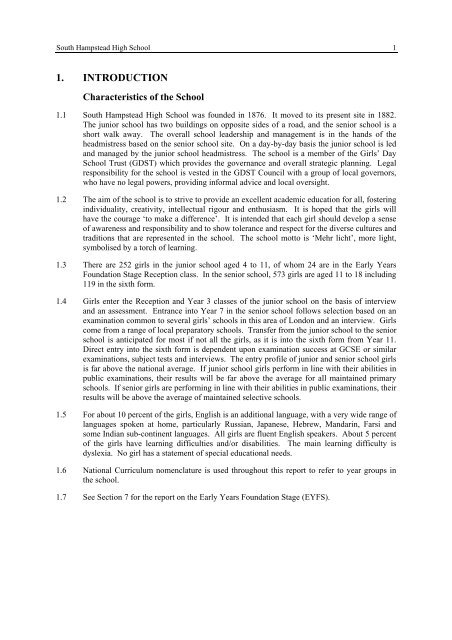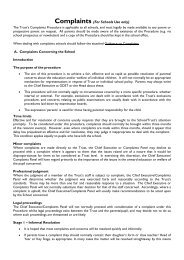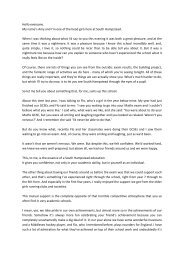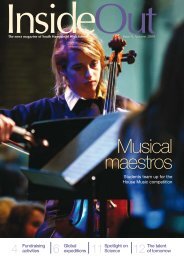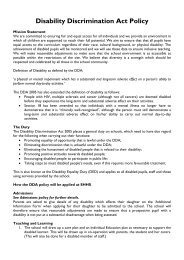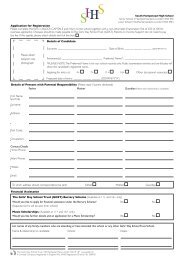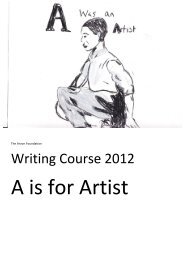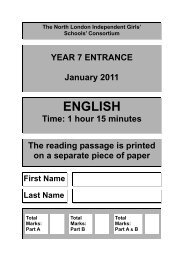Read more in the ISI Inspection Report. - South Hampstead High ...
Read more in the ISI Inspection Report. - South Hampstead High ...
Read more in the ISI Inspection Report. - South Hampstead High ...
Create successful ePaper yourself
Turn your PDF publications into a flip-book with our unique Google optimized e-Paper software.
<strong>South</strong> <strong>Hampstead</strong> <strong>High</strong> School 11. INTRODUCTIONCharacteristics of <strong>the</strong> School1.1 <strong>South</strong> <strong>Hampstead</strong> <strong>High</strong> School was founded <strong>in</strong> 1876. It moved to its present site <strong>in</strong> 1882.The junior school has two build<strong>in</strong>gs on opposite sides of a road, and <strong>the</strong> senior school is ashort walk away. The overall school leadership and management is <strong>in</strong> <strong>the</strong> hands of <strong>the</strong>headmistress based on <strong>the</strong> senior school site. On a day-by-day basis <strong>the</strong> junior school is ledand managed by <strong>the</strong> junior school headmistress. The school is a member of <strong>the</strong> Girls’ DaySchool Trust (GDST) which provides <strong>the</strong> governance and overall strategic plann<strong>in</strong>g. Legalresponsibility for <strong>the</strong> school is vested <strong>in</strong> <strong>the</strong> GDST Council with a group of local governors,who have no legal powers, provid<strong>in</strong>g <strong>in</strong>formal advice and local oversight.1.2 The aim of <strong>the</strong> school is to strive to provide an excellent academic education for all, foster<strong>in</strong>g<strong>in</strong>dividuality, creativity, <strong>in</strong>tellectual rigour and enthusiasm. It is hoped that <strong>the</strong> girls willhave <strong>the</strong> courage ‘to make a difference’. It is <strong>in</strong>tended that each girl should develop a senseof awareness and responsibility and to show tolerance and respect for <strong>the</strong> diverse cultures andtraditions that are represented <strong>in</strong> <strong>the</strong> school. The school motto is ‘Mehr licht’, <strong>more</strong> light,symbolised by a torch of learn<strong>in</strong>g.1.3 There are 252 girls <strong>in</strong> <strong>the</strong> junior school aged 4 to 11, of whom 24 are <strong>in</strong> <strong>the</strong> Early YearsFoundation Stage Reception class. In <strong>the</strong> senior school, 573 girls are aged 11 to 18 <strong>in</strong>clud<strong>in</strong>g119 <strong>in</strong> <strong>the</strong> sixth form.1.4 Girls enter <strong>the</strong> Reception and Year 3 classes of <strong>the</strong> junior school on <strong>the</strong> basis of <strong>in</strong>terviewand an assessment. Entrance <strong>in</strong>to Year 7 <strong>in</strong> <strong>the</strong> senior school follows selection based on anexam<strong>in</strong>ation common to several girls’ schools <strong>in</strong> this area of London and an <strong>in</strong>terview. Girlscome from a range of local preparatory schools. Transfer from <strong>the</strong> junior school to <strong>the</strong> seniorschool is anticipated for most if not all <strong>the</strong> girls, as it is <strong>in</strong>to <strong>the</strong> sixth form from Year 11.Direct entry <strong>in</strong>to <strong>the</strong> sixth form is dependent upon exam<strong>in</strong>ation success at GCSE or similarexam<strong>in</strong>ations, subject tests and <strong>in</strong>terviews. The entry profile of junior and senior school girlsis far above <strong>the</strong> national average. If junior school girls perform <strong>in</strong> l<strong>in</strong>e with <strong>the</strong>ir abilities <strong>in</strong>public exam<strong>in</strong>ations, <strong>the</strong>ir results will be far above <strong>the</strong> average for all ma<strong>in</strong>ta<strong>in</strong>ed primaryschools. If senior girls are perform<strong>in</strong>g <strong>in</strong> l<strong>in</strong>e with <strong>the</strong>ir abilities <strong>in</strong> public exam<strong>in</strong>ations, <strong>the</strong>irresults will be above <strong>the</strong> average of ma<strong>in</strong>ta<strong>in</strong>ed selective schools.1.5 For about 10 percent of <strong>the</strong> girls, English is an additional language, with a very wide range oflanguages spoken at home, particularly Russian, Japanese, Hebrew, Mandar<strong>in</strong>, Farsi andsome Indian sub-cont<strong>in</strong>ent languages. All girls are fluent English speakers. About 5 percentof <strong>the</strong> girls have learn<strong>in</strong>g difficulties and/or disabilities. The ma<strong>in</strong> learn<strong>in</strong>g difficulty isdyslexia. No girl has a statement of special educational needs.1.6 National Curriculum nomenclature is used throughout this report to refer to year groups <strong>in</strong><strong>the</strong> school.1.7 See Section 7 for <strong>the</strong> report on <strong>the</strong> Early Years Foundation Stage (EYFS).


